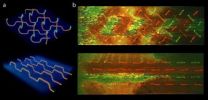(Press-News.org) All organisms, from mammals to fungi, have daily cycles controlled by a tightly regulated internal clock, called the circadian clock. The whole-body circadian clock, influenced by the exposure to light, dictates the wake-sleep cycle. At the cellular level, the clock is controlled by a complex network of genes and proteins that switch each other on and off based on cues from their environment.
Most genes involved in the regulation of the circadian clock have been characterized, but Akihiro Goriki, Toru Takumi and their colleagues from RIKEN and Hiroshima University in Japan and University of Michigan in the United States knew that a key component was missing and sough to uncover it in mammals.
In the study, the team performed a genome-wide chromatin immunoprecipitation analysis for genes that were the target of BMAL1, a core clock component that binds to many other clock genes, regulating their transcription.
The authors characterize a new circadian gene that they name Chrono. They show that CHRONO functions as a transcriptional repressor of the negative feedback loop in the mammalian clock: the protein CHRONO binds to the regulatory region of clock genes, with its repressor function oscillating in a circadian manner. The expression of core clock genes is altered in mice lacking the Chrono gene, and the mice have longer circadian cycles.
"These results suggest that Chrono functions as a core clock repressor," conclude the authors.
In addition, they demonstrate that the repression mechanism of Chrono is under epigenetic control and links, via a glucocorticoid receptor, to metabolic pathways triggered by behavioral stress.
These findings are confirmed by another study by the University of Pennsylvania, also published in PLOS Biology today. In the study, John Hogenesch and his team prove the existence of Chrono using a computer-based analaysis.
INFORMATION: END
Chrono, the last piece of the circadian clock puzzle?
2014-04-16
ELSE PRESS RELEASES FROM THIS DATE:
Casual marijuana use linked to brain abnormalities in students
2014-04-16
CHICAGO --- Young adults who used marijuana only recreationally showed significant abnormalities in two key brain regions that are important in emotion and motivation, scientists report. The study was a collaboration between Northwestern Medicine® and Massachusetts General Hospital/Harvard Medical School.
This is the first study to show casual use of marijuana is related to major brain changes. It showed the degree of brain abnormalities in these regions is directly related to the number of joints a person smoked per week. The more joints a person smoked, the more abnormal ...
Mothers with higher BMI have increased risk of stillbirth, infant death
2014-04-15
Higher maternal body mass index (BMI) before or in early pregnancy is associated with an increased risk of fetal death, stillbirth, and infant death, with women who are severely obese having the greatest risk of these outcomes from their pregnancy, according to a study in the April 16 issue of JAMA.
Worldwide, approximately 2.7 million stillbirths occurred in 2008. In addition, an estimated 3.6 million neonatal deaths (death following live birth of an infant but before age 28 days) occur each year. Several studies have suggested that greater maternal body mass index ...
Thyroid disease risk varies among blacks, Asians, and whites
2014-04-15
An analysis that included active military personnel finds that the rate of the thyroid disorder Graves disease is more common among blacks and Asian/Pacific Islanders compared with whites, according to a study in the April 16 issue of JAMA.
Donald S. A. McLeod, F.R.A.C.P., M.P.H., of the QIMR Berghofer Medical Research Institute, Queensland, Australia and colleagues studied all U.S. active duty military, ages 20 to 54 years, from January 1997 to December 2011 to determine the rate of Graves disease and Hashimoto thyroiditis (a progressive autoimmune disease of the thyroid ...
Pre-diabetes and diabetes nearly double over the past 2 decades
2014-04-15
Cases of diabetes and pre-diabetes in the United States have nearly doubled since 1988, suggests new research from the Johns Hopkins Bloomberg School of Public Health, with obesity apparently to blame for the surge. The researchers also found that the burden of the disease has not hit all groups equally, with alarming increases in diabetes in blacks, Hispanics and the elderly.
According to new research reported in the April 15, 2014 issue of the Annals of Internal Medicine, diabetes increased from 6 percent to 10 percent in the past two decades and pre-diabetes also doubled ...
Drought hormones measured
2014-04-15
Stanford, CA—Floods and droughts are increasingly in the news, and climate experts say their frequency will only go up in the future. As such, it is crucial for scientists to learn more about how these extreme events affect plants in order to prepare for and combat the risks to food security that could result.
Like animals, plants have hormones that send chemical signals between its cells relaying information about the plant's development or interactions with the outside world. One particular way in which plants use hormone signals is in reaction to drought or soil saltiness. ...
Scholars propose new standards for gauging muscle decline in older adults
2014-04-15
Sarcopenia — the age-related loss of muscle mass and strength — may put up to 50 percent of seniors at greater risk for disability, yet there is no consensus within the medical community for how this condition should be measured. However, a new collection of articles appearing in The Journals of Gerontology, Series A: Biological Sciences and Medical Sciences (volume 69, number 5) lays out an empirically derived set of criteria for diagnosing sarcopenia.
These recommendations are a result of the Foundation for the National Institutes of Health Biomarkers Consortium Sarcopenia ...
New technique will accelerate genetic characterization of photosynthesis
2014-04-15
Stanford, CA— Photosynthesis provides fixed carbon and energy for nearly all life on Earth, yet many aspects of this fascinating process remain mysterious. For example, little is known about how it is regulated in response to changes in light intensity. More fundamentally, we do not know the full list of the parts of the molecular machines that perform photosynthesis in any organism.
A type of single-cell green algae called Chlamydomonas reinhardtii is a leading subject for photosynthesis research. Despite its importance in the research world, few tools are available ...
The human food connection: A new study reveals more about our relationship to food
2014-04-15
Tucked away in Hartford, Connecticut, a Puerto Rican community is creating a tropical home away from home through cuisine that is so authentic it has caught the attention of scientists. David W. Taylor (University of Portland) and Gregory J. Anderson (University of Connecticut) took a close look at the fresh crops in the Puerto Rican markets of Hartford and uncovered evidence that gives new meaning to a phrase that food lovers have been using for years: home is in the kitchen.
"Culinary preferences tell us a good deal about human culture, what is important, and what constitutes ...
Odd tilts could make more worlds habitable
2014-04-15
Pivoting planets that lean one way and then change orientation within a short geological time period might be surprisingly habitable, according to new modeling by NASA and university scientists affiliated with the NASA Astrobiology Institute.
The climate effects generated on these wobbling worlds could prevent them from turning into glacier-covered ice lockers, even if those planets are somewhat far from their stars. And with some water remaining liquid on the surface long-term, such planets could maintain favorable conditions for life.
"Planets like these are far enough ...
Repeated self-healing now possible in composite materials
2014-04-15
Internal damage in fiber-reinforced composites, materials used in structures of modern airplanes and automobiles, is difficult to detect and nearly impossible to repair by conventional methods. A small, internal crack can quickly develop into irreversible damage from delamination, a process in which the layers separate. This remains one of the most significant factors limiting more widespread use of composite materials.
However, fiber-composite materials can now heal autonomously through a new self-healing system, developed by researchers in the Beckman Institute's Autonomous ...


